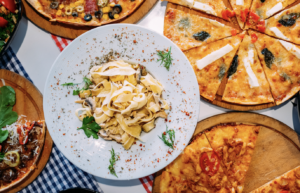Improving Restaurant Operations: From Costs to Customers

Running a successful restaurant involves dutiful management of various operational aspects to ensure efficiency, cost-effectiveness, and customer satisfaction. Understanding how to improve restaurant operations can help to make informed decisions about menu changes, staffing, purchasing, inventory, and any ongoing costs you may encounter.
This blog delves into several critical strategies that can significantly improve restaurant operations because effective operations management not only boosts profitability but also creates a positive environment for your business to thrive, setting the stage for long-term success.
Manage Operating Costs
Effectively managing operating costs is fundamental to the financial health of your restaurant. Managing these effectively involves strategic planning and negotiation. Here’s how to do it:
Fixed Costs
Lease Agreements
Regularly review your lease agreements and engage in proactive negotiations with your landlord to secure favourable terms. Being well-informed about real estate and understanding of your business’s value to the landlord can provide leverage in these negotiations.
Energy Efficiency
Regularly audit your utility usage and invest in energy-efficient appliances. These investments not only lower your utility bills but also contribute to a more sustainable operation, which can be a selling point for environmentally-conscious customers.
Insurance and Software
Evaluate your insurance policies periodically to ensure you are adequately covered without overpaying and opt for solutions that offer comprehensive packages or negotiate better rates with your current providers.
Variable Costs
Labour Costs
Optimise labour costs by using data from your POS system to forecast busy and slow times accurately. Schedule staff accordingly to prevent overstaffing during slow periods and understaffing during peak times. This controls both labour costs and service quality by having the right number of staff on hand. Plan to have your most experienced and efficient staff at the busiest times and keep training to the quieter times.
Strategic Planning
Marketing Budget
Allocate your marketing budget wisely by focusing on high-impact, low-cost strategies such as social media marketing, email campaigns, and community events. These methods can reach a broad yet targeted audience.
Data-Driven and Customer Feedback
Harnessing data from various sources can provide invaluable insights into your restaurant’s performance, which can help optimise your operational costs. Assess data from any software used to track sales trends and identify popular items.
Actively seeking and analysing customer feedback can also enhance customer satisfaction and loyalty. Use surveys, online reviews and in-person comments to gather opinions. Feedback creates clear patterns of strengths and weaknesses. Take a holistic and experimental approach to feedback, making considered decisions in response.
By focusing on these strategies, you can create systems to properly manage your ongoing operating costs, ensuring your restaurant remains financially healthy and competitive in the market.
Tech Integration
Integrating the right technology into your restaurant operations can streamline processes, improve customer experience, and increase profitability. These four important and widely used systems help optimise operations at your restaurant:
Point-of-Sale System: A modern POS system does more than just process transactions. It can also track sales data and provide detailed reports. Choosing a system that integrates with other tools minimises manual entry and reduces errors. Integrating an inventory management system or using an inbuilt inventory function is a popular way of streamlining ordering and stock counting processes.
Reservation Management Systems: Implementing a reservation management system allows you to manage reservations seamlessly and gather data on customer preferences. This helps to optimise seating, reduce wait times, and improve the overall dining experience.
Staff Scheduling Systems: Staff scheduling systems can ensure optimal staffing levels, prevent overstaffing, and reduce labour costs. Automated scheduling can also improve employee satisfaction by providing more predictable schedules.
Customer Relationship Management: A CRM system helps manage customer interactions by using automated messaging, such as reservation confirmations and follow-ups. Aggregated data from CRM systems can provide insights into customer behaviour, which can help better understand customer engagement.
Investing in the right technology saves time and money as it helps you comprehend restaurant-specific trends, allowing you to tailor your offerings and improve customer experience.

Reducing Food Waste
A major variable cost that has not been discussed yet is food. Efficient ingredient management is crucial for reducing food waste and controlling costs.
Inventory Management
Regularly reviewing inventory reports helps in making informed purchasing decisions, aligning stock levels with actual demand. Additionally, implementing a robust inventory management system to track stock levels accurately will help reduce waste.
Contracting the Correct Vendors
Work with reliable vendors who offer quality ingredients at competitive prices. Plus, establishing long-term relationships with multiple suppliers can help to find the best market price, negotiate better terms, and ensure consistent quality for your ingredients.
Investing in high-quality ingredients may be more expensive upfront, however, they can enhance the taste and appeal of your dishes, leading to higher customer satisfaction and repeat business.
Design your menu to promote profitable items and streamline options to simplify kitchen operations and reduce waste. Menu engineering is a strategic approach to design dishes through regularly reviewing food costs and adjusting menu prices accordingly to ensure that price changes reflect the value perceived by customers.
This involves analysing and categorising menu items based on profitability and popularity. This strategy prioritises ingredient optimisation by using common ingredients across multiple dishes to reduce inventory costs and minimise waste.
Stay ahead of industry news and competitor offerings to regularly update your menu so that it reflects current trends while maintaining a balance with your restaurant’s unique identity.
Other than creating dishes for a cohesive menu, your menu can be streamlined through design and development. This involves considering layout, descriptive language, visual elements, and size. Effectively highlighting unique dishes, using high-quality imagery and implementing appropriate pricing strategies will directly enhance the dining experience but also drive sales and profitability.
Staff Training
Well-trained staff are essential for efficient operations and exceptional customer service. Staff training should include trends in preparation and how this should be handled, from remembering pre-cooking cleanliness and organisation to recipe consistency and quality checking.
Standard Operating Procedures (SOPs)
Develop comprehensive manuals outlining standard operating procedures (SOPs) because they ensure consistency and help new employees get up to speed quickly. These guidelines should cover all aspects of your restaurant’s operations, from food preparation and inventory to customer service
Compliance
Train your staff on the importance of cleanliness, organisation, and recipe consistency during food preparation. Regularly train staff on health and safety regulations, food handling procedures, and any relevant legal requirements. This helps prevent violations and fines whilst creating a safe dining environment.
Customer Service
In terms of service, all staff should be briefed on upholding effective communication, problem-solving, and conflict resolution whilst remaining friendly and inviting. Positive service experiences lead to higher customer satisfaction and repeat visits.
Implementing these well-outlined steps into your training will not only improve efficiency but also guarantee a consistent, high-quality dining experience for your customers.
By focusing on these key areas, restaurant owners and managers can significantly improve their operations, from managing costs to enhancing the customer experience.
How the Engine Room Can Help Your Restaurant Business
The Engine Room specialises in restaurant consultancy to help you understand the mutual relationship between the financial and operational side of your restaurant business so that you can optimise day-to-day restaurant operations. Contact our team today on 020 3960 5137 or via email at enquiries@the-engineroom.co.uk



